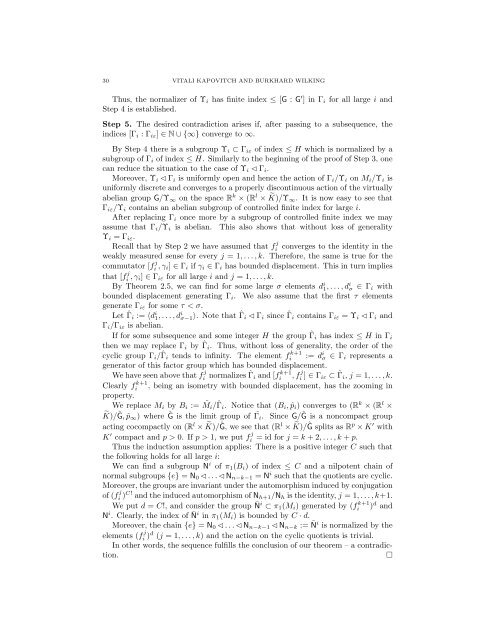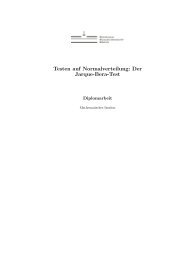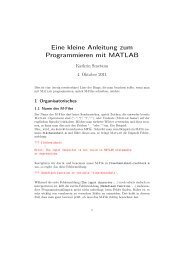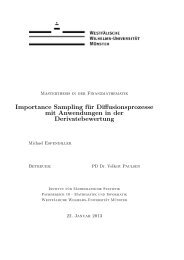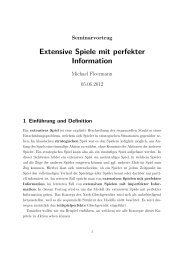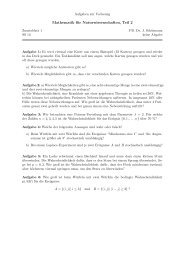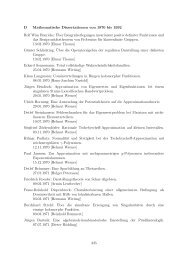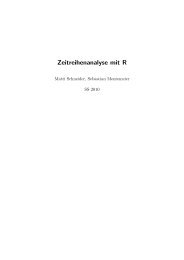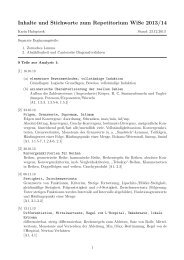Margulis Lemma
Margulis Lemma
Margulis Lemma
Create successful ePaper yourself
Turn your PDF publications into a flip-book with our unique Google optimized e-Paper software.
30 VITALI KAPOVITCH AND BURKHARD WILKING<br />
Thus, the normalizer of Υ i has finite index ≤ [G : G ′ ] in Γ i for all large i and<br />
Step 4 is established.<br />
Step 5. The desired contradiction arises if, after passing to a subsequence, the<br />
indices [Γ i : Γ iε ] ∈ N ∪ {∞} converge to ∞.<br />
By Step 4 there is a subgroup Υ i ⊂ Γ iε of index ≤ H which is normalized by a<br />
subgroup of Γ i of index ≤ H. Similarly to the beginning of the proof of Step 3, one<br />
can reduce the situation to the case of Υ i ⊳ Γ i .<br />
Moreover, Υ i ⊳ Γ i is uniformly open and hence the action of Γ i /Υ i on M i /Υ i is<br />
uniformly discrete and converges to a properly discontinuous action of the virtually<br />
abelian group G/Υ ∞ on the space R k × (R l × ˜K)/Υ ∞ . It is now easy to see that<br />
Γ iε /Υ i contains an abelian subgroup of controlled finite index for large i.<br />
After replacing Γ i once more by a subgroup of controlled finite index we may<br />
assume that Γ i /Υ i is abelian. This also shows that without loss of generality<br />
Υ i = Γ iε .<br />
Recall that by Step 2 we have assumed that f j i converges to the identity in the<br />
weakly measured sense for every j = 1, . . . , k. Therefore, the same is true for the<br />
commutator [f j i , γ i] ∈ Γ i if γ i ∈ Γ i has bounded displacement. This in turn implies<br />
that [f j i , γ i] ∈ Γ iε for all large i and j = 1, . . . , k.<br />
By Theorem 2.5, we can find for some large σ elements d i 1, . . . , d i σ ∈ Γ i with<br />
bounded displacement generating Γ i . We also assume that the first τ elements<br />
generate Γ iε for some τ < σ.<br />
Let ˆΓ i := 〈d i 1, . . . , d i σ−1〉. Note that ˆΓ i ⊳ Γ i since ˆΓ i contains Γ iε = Υ i ⊳ Γ i and<br />
Γ i /Γ iε is abelian.<br />
If for some subsequence and some integer H the group ˆΓ i has index ≤ H in Γ i<br />
then we may replace Γ i by ˆΓ i . Thus, without loss of generality, the order of the<br />
cyclic group Γ i /ˆΓ i tends to infinity. The element f k+1<br />
i := d i σ ∈ Γ i represents a<br />
generator of this factor group which has bounded displacement.<br />
We have seen above that f j i normalizes ˆΓ i and [f k+1<br />
i , f j i ] ∈ Γ iε ⊂ ˆΓ i , j = 1, . . . , k.<br />
Clearly f k+1<br />
i , being an isometry with bounded displacement, has the zooming in<br />
property.<br />
We replace M i by B i := ˜M i /ˆΓ i . Notice that (B i , ˆp i ) converges to (R k × (R l ×<br />
˜K)/Ĝ, ˆp ∞) where Ĝ is the limit group of ˆΓi . Since G/Ĝ is a noncompact group<br />
acting cocompactly on (R l × ˜K)/Ĝ, we see that (Rl × ˜K)/Ĝ splits as Rp × K ′ with<br />
K ′ compact and p > 0. If p > 1, we put f j i = id for j = k + 2, . . . , k + p.<br />
Thus the induction assumption applies: There is a positive integer C such that<br />
the following holds for all large i:<br />
We can find a subgroup N i of π 1 (B i ) of index ≤ C and a nilpotent chain of<br />
normal subgroups {e} = N 0 ⊳ . . . ⊳ N n−k−1 = N i such that the quotients are cyclic.<br />
Moreover, the groups are invariant under the automorphism induced by conjugation<br />
of (f j i )C! and the induced automorphism of N h+1 /N h is the identity, j = 1, . . . , k+1.<br />
We put d = C!, and consider the group ¯N i ⊂ π 1 (M i ) generated by (f k+1<br />
i ) d and<br />
N i . Clearly, the index of ¯N i in π 1 (M i ) is bounded by C · d.<br />
Moreover, the chain {e} = N 0 ⊳ . . . ⊳ N n−k−1 ⊳ N n−k := ¯N i is normalized by the<br />
elements (f j i )d (j = 1, . . . , k) and the action on the cyclic quotients is trivial.<br />
In other words, the sequence fulfills the conclusion of our theorem – a contradiction.<br />
□


